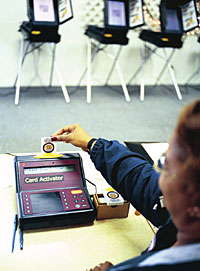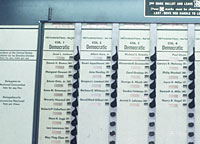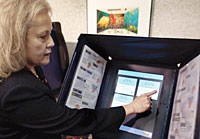(From The Institute print edition)
Standing Up For a Better E-Ballot Box
BY ERICA VONDERHEID
It
won’t be ready for this year’s U.S. presidential election, but the hope
is that it will be ready before the next one, four years hence. We’re
talking about an IEEE standard that specifies the performance
requirements of electronic voting machines.
The
standard being developed is the IEEE 1583 “Standard for the Evaluation
of Voting Equipment.” It is a performance standard, which means it
won’t specify how a voting machine should be designed or manufactured.
Instead, the standard outlines what a voting machine must do—for
example, maintain the confidentiality of the voter’s choice, withstand
hacking, be easy for voters to use, and take into account voters’
physical disabilities or language difficulties. The standard will also
define the levels of electromagnetic interference the voting machine
must withstand. Such interference could be caused, for example, by
mobile electronic devices brought into the polling place.
 A
voter inserts her voter-identification card into a management terminal
that will clear her to use one of the touch-screen voting machines in
the background. A
voter inserts her voter-identification card into a management terminal
that will clear her to use one of the touch-screen voting machines in
the background.
Once
IEEE 1583 is accepted by the U.S. Election Assistance Commission (EAC),
it will be the law of the land, and all voting machines used in federal
elections will have to meet the standard.
“We’re
not saying what kind of technology a voting machine should use,”
explains IEEE Member Stephen Berger, a member of the IEEE 1583 working
group. “The standard stops well short of anything that would lock in
one kind of approach to voting over another.” The standard presents
requirements that voting machines must meet, Berger continues, yet the
requirements are general enough to cover any computerized voting
machine, including touch-screen devices and optical scanning machines.
Punch-card, lever, or other mechanical voting machines will not be
covered, however.
The
EAC is a new government agency charged by the U.S. Congress with
developing technical guidelines for voting machinery. IEEE 1583 is the
first in a number of election standards. The agency must also develop
standards for ancillary equipment such as central tabulating equipment
and software for registering voters. However, guidelines for how voting
equipment should be tested will be incorporated in IEEE 1583. Another
task is to develop guidelines for the various activities involved in
running an election, which include registering voters and counting
ballots.
DOING BETTER The
idea for the IEEE standard originated with members of the IEEE New York
Section. Chagrined by the problems with punch-card ballots in the 2000
U.S. Presidential election, they believed that a standard for
electronic voting machines that could replace punch cards would be the
best way to apply the IEEE’s technical know-how and influence. A group
of engineers headed by Berger came together in mid-2001 to brainstorm
how to improve voting equipment. Given the importance of the issue, the
IEEE Standards Association (IEEE-SA) decided that it would sponsor a
standard for such equipment—the first instance where an IEEE society
did not take responsibility for a standard’s scope and content. After
taking several months to enlist experts and get organized, Berger’s
group began working with the National Association of State Election
Directors, whose members are responsible for the voting machines and
voting procedures in each state, and the U.S. Federal Election
Commission (FEC), which oversees how U.S. elections are funded.
 The
IEEE 1583 e-voting standard will specify performance guidelines for
electronic machines that will replace mechanical machines such as this
lever-activated device still in use in New York City. The
IEEE 1583 e-voting standard will specify performance guidelines for
electronic machines that will replace mechanical machines such as this
lever-activated device still in use in New York City.
The
IEEE was not alone in its concern for the security and performance of
voting machines. In October 2002, the U.S. Congress passed the Help
America Vote Act (HAVA) which included money–US$2.3 billion this
year–for the states to spend on replacing old punch-card and
lever-actuated voting systems.
The
act, which called for setting up the EAC, also required that a
representative from the IEEE sit on the commission’s Technical
Guidelines and Development Committee (TGDC). The committee will write
standards for the ancillary election equipment.
“We
were very flattered that Congress saw that we had a contribution to
make and gave us a permanent place to make it,” says Berger, who
represents the IEEE on the committee. Though the act creating the TGDC
was passed in 2002, the committee had its first organizational meeting
only last June because of the time it took to choose its members.
The
IEEE 1583 working group’s first task was to look at existing
election-equipment standards, including those issued in a two-volume
set by the FEC in 1990. These standards hadn’t kept pace with newer
technology such as touch-screen machines or machines that print out a
paper record for the voter to double-check before leaving the voting
booth, notes Herb Deutsch, chair of the IEEE 1583 working group.
The
FEC standards deal with how the machines must be built and says nothing
about the software that voting-equipment manufacturers later developed.
The FEC standard is a performance standard, as is IEEE 1583, but it
covers the hardware and software involved in an election with a very
broad brush.
Shortly
after the IEEE’s working group was organized, it provided more than 30
pages of comments on the FEC’s 1990 electronic voting machine standard,
which was being updated. The IEEE considered ways that electronics
could keep each vote confidential and make the machine easier for the
voter to use than punch-card or lever machines. Berger reports the FEC
adopted most of the IEEE’s recommendations. The working group then used
them as a jumping-off point for its own standard.
REACTING TO COMMENTS The
IEEE 1583 working group reached its first milestone in August 2003 when
it completed its “Draft Standard for the Evaluation of Voting
Equipment.” The draft was sent for voting to all working group
members—more than 200 people from eight countries—and the IEEE-SA.
 The IEEE standard will encompass touch-screen voting machines such as this one being used in Tallahassee, Fla., USA. The IEEE standard will encompass touch-screen voting machines such as this one being used in Tallahassee, Fla., USA.
The
working group, which meets about every three months, is composed of
IEEE members and representatives from voting-machine manufacturers,
standards groups, disability advocates, and other professional
organizations. The latter include the Information Systems Security
Association, whose members are experts on hacking a computer system and
guarding against it, and the U.S. National Association of Radio and
Telecommunications Engineers, whose members contribute their expertise
on electromagnetic interference.
The
257-page standard was not approved, which is not unusual for a first
draft. But along with the balloting, the working group received more
than 1000 comments on the draft standard, including suggestions for
changes. The group’s next job was to address the comments. Berger says
the second draft of the standard may be ready for another vote—and more
comments—by the end of the year.
Not
everyone agrees, however, with how the standard is being developed.
Some critics feel the standard may do more harm than good. David Dill,
an IEEE Fellow, professor of computer science at Stanford University in
California, USA, and a member of the IEEE 1583 working group, is
uncomfortable that representatives from voting-machine vendors dominate
the group. The group could endorse a standard whose guidelines are good
for their companies, and not good for voters, he says.
“I
have serious reservations about the appropriateness of the IEEE
standards process for something that is as important as the foundation
of democracy,” says Dill, who was also a co-editor of a special issue
of IEEE Security and Privacy magazine devoted to e-voting [see “Magazine Tackles Security of E-Voting ” ].
Berger
reports, however, that the working group is taking heed of such
criticism. It delayed release of its second draft standard by a year to
provide enough time for the comments to be considered and, when
desirable, to be worked into the draft. One result was that
requirements for equipment that provides a voter-verifiable paper
receipt were added.
According
to Berger, the standard could also be of value outside the United
States. “Other countries may want to adopt the standard, and if there
are differences in their election laws or practices we might develop
amendments to accommodate them,” he says. He notes that in some
European countries, votes are not anonymous—a voter’s name is attached
to each ballot—which differs from IEEE 1583’s confidentiality
requirement. Representatives from Europe and Asia are participating in
the IEEE 1583 working group and could develop their own ideas for
voting equipment in their countries.
To learn more about IEEE 1583, visit IEEE-SA at http://standards.ieee.org. |

